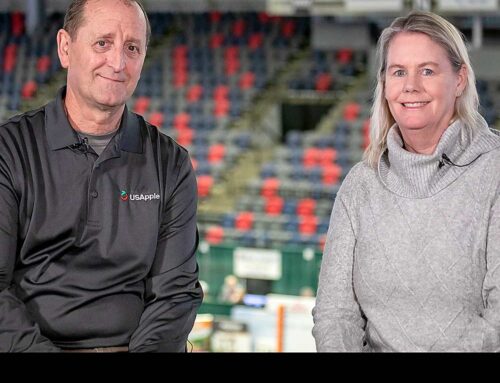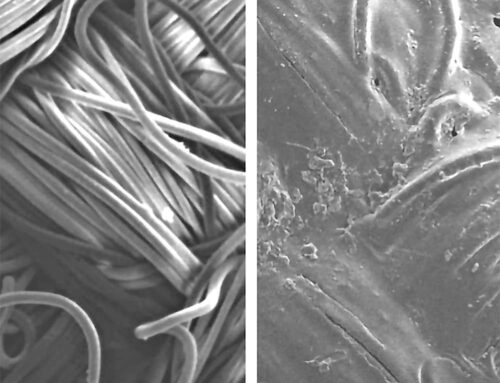Postharvest decay of apples and pears is not just a postharvest problem. Dr. Chang-Lin Xiao, plant pathologist with Washington State University in Wenatchee, advocates a holistic approach to managing decay because fruit can be infected in the orchard as well as during postharvest handling and storage.
“What we’ve done in the orchard and what we’ve done at harvest will affect decay before and after packing,” he explained during an Apple Fruit Quality meeting organized by WSU Extension in Yakima this summer. “And what we do during packing can affect decay in the boxes, which sometimes shows up after marketing.”
Orchard infection
Infections of Sphaeropsis rot, Phacidiopycnis rot, and bull’s-eye rot begin in the orchard, even though there might be no symptoms at harvest. Fruit with latent infections start to develop symptoms during storage. Sphaeropsis rot is a recently reported disease of apples and pears.
It was first found on d’Anjou pears, but can cause even more serious problems on apples. The disease originates from infections at the stem or calyx of the fruit and can be misdiagnosed as gray mold. However, Sphaeropsis rot has a distinct “bandagelike” odor in the decayed flesh. Phacidiopycnis rot has only recently been reported in North America. In Washington State, it is common on pears, and less so on apples.
It also can be confused with gray mold. Infections can begin at the stem or calyx ends or through wounds on the skin of the fruit. Bull’s-eye rot affects both apples and pears. It often originates from infected lenticels, though it can also infect the stem or calyx ends of the fruit. In Washington it is commonly seen on Golden Delicious and Gala apples from orchards with overtree evaporative cooling or irrigation.
The fungi that cause these decays are on the trees in the orchard, often on dead bark, twigs that show signs of dieback, or cankers. They are not likely to be found in the packing house, Xiao said. Water is required for the fungi’s fruiting bodies to release spores.
The spores are dispersed in the orchard by water, and irrigation water creates favorable conditions. Strategies for controlling these diseases include removing cankers or twigs with dieback to reduce the inoculum level. Avoid overtree irrigation and minimize the duration of evaporative cooling.
Xiao recommends applying fungicides before harvest. In his trials on d’Anjou pears, an application of ziram two weeks before harvest provided up to 70 percent control of Phacidiopycnis rot. The ziram treatment produced similar control of Sphaeropsis rot on apples. The fungicide has a 14-day preharvest interval.
Packing house
Gray mold (Botrytis) and blue mold (Penicillium) infections originate in wounds, such as stem punctures or stem bow splits, which can be contaminated by drench solution or water systems during packing. Decay shows up during storage, and in the case of the gray mold, which can spread from fruit to fruit, losses can be significant. Sources of the inoculum include orchard debris, decayed fruit on the orchard floor, soil, and dead bark on the trees.
Spores are in the air and on the surface of the fruit. They are dispersed mainly by air currents, wind, and splashing water. Bins can be contaminated by blue mold spores that are resistant to the standard postharvest fungicide, TBZ (thiobendazole, sold under the brand name Mertect), and brought back to the orchard. To control postharvest diseases, growers and packers need to work together, Xiao said.
Growers should have a good sanitation program to reduce inoculum levels in the orchard. They should remove thinned or fallen fruit and plant debris from the orchard floor. They should also remove decayed fruit left on the trees; otherwise, this can be a source of inoculum for adjacent later-harvested varieties. Dead branches and cankers should be pruned out, and a fungicide should be applied either before harvest or after harvest but before storage.
“A preharvest fungicide is particularly important for fruit for long-term storage that are not going to be treated with a postharvest fungicide before they are put in storage,” Xiao emphasized. A preharvest fungicide can: —control latent infections in the orchard, —reduce the spore load and the decay pathogens on the fruit surface, and —help prevent infection of wounds by decay pathogens.
Good coverage is the key to success of a preharvest fungicide program for decay control, Xiao said, and he recommends a high gallonage spray. Packers should sanitize water systems and equipment and use postharvest fungicides, Xiao said.
Fungicides
Several fungicides are available for preharvest use in addition to ziram. There’s the benzamidazole fungicide Topsin (methyl thiophenate), the strobilurin Flint (trifloxystrobin), and Pristine, which contains two active ingredients: pyraclostrobin (a strobilurin) and boscalin (a broad-spectrum carboxamide fungicide).
Registration of Elevate (fenhexamid), an anilide fungicide, is pending. Xiao said that in trials on Fuji last season, Elevate was effective against gray mold, but not effective against blue mold. Topsin was good for blue mold control, but not as good for gray mold control. Pristine gave excellent control of both. Pristine is also effective against powdery mildew and scab, but the drawback is a high risk of the pathogens developing resistance.
Xiao warns against making more than four applications of strobilurin fungicides per season, including the one applied close to harvest for decay control. Xiao recommends growers reserve Pristine for use just before harvest and use other fungicides for control of mildew and scab. There is unlikely to be cross resistance of Pristine and the postharvest fungicides Mertect (TBZ) and Penbotec.
Topsin and Mertect come from the same benzamidazole chemistry, so the risk of cross resistance is high, Xiao warned. In the past, because TBZ was generally the only fungicide used in the packing house, benzamidazoles were not recommended in the orchard. Xiao still recommends that if the fruit will be treated with TBZ in the packing house, it should not be treated with Topsin in the orchard.
With the registration of new products, packers now have a choice between TBZ, Scholar (fludioxonil), and Penbotec (pyrimethanil), and there should be no cross resistance between the three. They can be used as a prestorage drench or on the packing line, but Xiao recommends only using each fungicide once.
In trials on Red Delicious, treatment with Scholar or Penbotec resulted in less than 1 percent decay from gray mold, compared with 2 percent in TBZ-treated fruit and 11 percent in the untreated. “I believe fungicides remain an essential component for decay management,” he said.
He encourages producers to consider the various combinations of pre and post harvest treatments. More information on diagnosis of postharvest diseases can be found on the Web site at http://decay.tfrec.wsu.edu.




Leave A Comment